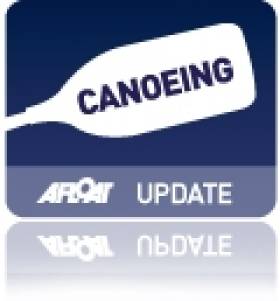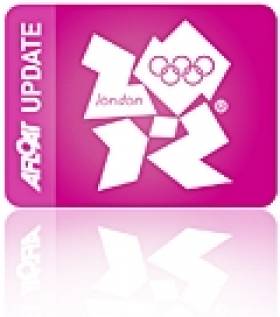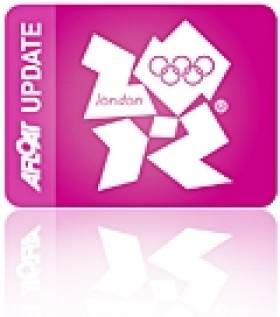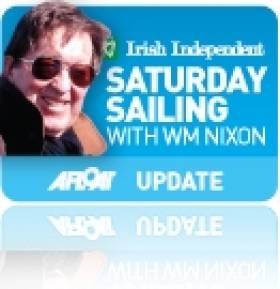Displaying items by tag: Olympic
Irish 49er Duo Take a Rest in 11th Overall
#49er – Ryan Seaton and Matt McGovern dropped out of the top ten of the 49er skiff class yesterday after their fifth consecutive day of racing to be 11th overall as the fleet pause for a rest today.
The Belfast pair had three races this afternoon taking 14th, 7th and 15th respectively. Race ten was one of their most impressive races of the event. Even though they ultimately finished in 7th place, they held their own with the best in the world shifting from 4th to 5th place and keeping ahead of the overall leaders; Outteridge and Jensen (AUS) until the very end of the race. Seaton and McGovern are currently 11th overall on 97 points.
The Australians, Outteridge and Jensen, hold the lead on 42 points followed by Burling and Tuke (GBR) on 51 and Lehtinen and Bask (FIN) on 66 points. The 49er class have a rest day today and resume on Sunday.
O'Leary and Burrows Prepare for Star Class Swan Song
#Star – There is disappointment for Ireland's Peter O'Leary and David Burrows because although they sail in tomorrow's Olympic medal race – a significant achievement in itself – they are not in contention for a medal. The Cork-Dubin duo who came together three years ago for a final assault in the mens keelboat will nevertheless compete in the final race of the Star as an Olympic keelboat. The famous design has been ditched from the 2016 regatta after 100 years of involvement in favour of kitesurfing. Any result achieved by the pair inside the top ten will be Ireland's best ever result in the class.
O'Leary and Burrows finished fleet racing yesterday in ninth place overall and with 75 points. Leaders Percy and Simpson (GBR) have 18 points, followed by Scheidt and Prada (BRA) on 26 points and Loof and Salminen (SEW) on 30 points.
In Friday's final fleet racing qualification for the medal race hinged on the two final races.
The pair rounding the first mark of Race 9 in 10th place. However, they were 14th rounding the second mark and just didn't manage to break the top 10 again finishing the race in 11th. Not letting that deter them, O'Leary and Burrows came out fighting in Race 10; the final fleet race. In the first leg they moved from 11th to 5th to eventually finish in 7th place, less than 90 seconds behind the leaders Percy & Simpson (GBR).
Irish Star Duo 'Disqualified' from Race Seven in Weymouth
#olympic sailing – Peter O'Leary and David Burrows have been disqualified (DSQ) from this morning's race seven of the Star Class Olympic regatta following a protest taken by Denmark's (DEN) Michael Hestbaek over an incident on the water between the Irish and Danish yachts.
According to a notice published by the protest jury tonight O'Leary has been disqualified from the race because he 'failed to give mark-room' to a boat overlapped inside of the Irish boat, breaking rule 18.2(b). The full jury decision is published on the official site here. (Scroll down to read the full jury decision below).
The jury found that during the first rounding of the windward mark, DEN and IRL were sailing on port tack, DEN to windward of IRL, with strong wind, waves and current. When DEN was within two boat lengths from the mark, the two boats luffed in order to tack. Shortly after passing head-to-wind the boats came close to each other. There was contact between the bow of IRL and the starboard quarter of DEN. The boats then bore down to close-hauled on starboard tack and sailed around the mark, with DEN in front. Neither boat was damaged, nor did they do penalty turns according to the jury.
On the water incidents between competing boats are a regular and normal part of sailing competition. A protest is a standard procedure to resolve disputes between competitors under the racing rules of sailing.

O'Leary and Burrows had a strong start in Race 7 this afternoon. Rounding the second mark they were in fourth, ahead of rivals Robert Scheidt and Bruno Prada (BRA) but while the Brazilians progressed to finish third, O'Leary and Burrows slipped back to finish in 9th but tonight this result has been changed to a DSQ.
In race 8 the Irish duo finished seventh.
O'Leary and Burrows now sit 9th overall on 51 points. Leaders Iain Percy and Andrew Simpson (GBR) are on 13 points while the Brazilians in second are on 22 points. The Star class have a final two fleet races tomorrow before the top 10 progress to the double points medal race on Sunday, 5th August.
In the 49er class Ryan Seaton and Matt McGovern, who have been sailing for four consecutive days, put in another solid performance to hold on to their spot as 9th overall on the leader board. They began Race 7 in 16th place but quickly moved up the ranks to finish just outside the top 10 in 11th. Race 8 saw them better themselves further, finishing a respectable 9th, which was enough for them to remain in 9th overall on 61 points. The Australians, Outteridge and Jensen, hold the lead on 24 points followed by Morrison and Rhodes (GBR) on 35 and Burling and Tuke (GBR) on 41. The 49er class will continue to race tomorrow before their well-earned rest day on Saturday.
Today was the long awaited first day of racing for the Irish 470 duo, Ger Owens, sailing at his third Olympics and Scott Flanigan. Flanigan is the youngest of the Irish sailors at just 19. They got off to a solid start holding position in the middle of the 27 boat fleet, working their way up to 15th during the middle of the race. They didn't quite manage to hold on to their spot and slipped back to finished 18th. They didn't fare as well in Race 2 finishing in 25thplace. They will continue sailing tomorrow, beginning the day in 23rd overall.
Today was the rest day for both the Laser Radial and the Laser fleets. Annalise Murphy remains in first overall and James Espey remains in 45th overall. Both classes will resume racing tomorrow.
Racing will continue tomorrow for all classes with a total of 11 races being sailed by Irish competitors. Sailing action starts at 12 noon in Weymouth.
Protest No. 34
Event: Star - Men
Race: 7
Protestor: DEN
Protestee: IRL
Protest details: Rule 18
Description:
Facts found:
Protestor represented by: Michael Hestbaek, protestee represented by Peter O"Leary
Notes on procedure: The protestee questioned validity, as the description of the incident was only a diagram with no text. The Jury found that there was enough information on the protest (time and location of incident, identity of protestor and protestee and diagram) to identify the incident as required by RRS 61.2(b)
During the first rounding of the windward mark, DEN and IRL were sailing on port tack, DEN to windward of IRL, with strong wind, waves and current. When DEN was within two boat lengths from the mark, the two boats luffed in order to tack. Shortly after passing head-to-wind the boats came close to each other. There was contact between the bow of IRL and the starboard quarter of DEN. The boats then bore down to close-hauled on starboard tack and sailed around the mark, with DEN in front. Neither boat was damaged, nor did they do penalty turns.
Conclusion:
By not giving room to tack to DEN overlapped to windward and on the inside of her, IRL failed to give mark-room to a boat overlapped inside of her, breaking rule 18.2(b). She also broke rule 14. DEN broke rule 13 by not keeping clear of IRL when both were subject to rule 13 as she was on IRL"s port side; however she is exonerated under rule 18.5(a). DEN didn"t break rule 14.
Rule(s) applicable:
13,14, 18.2(b), Definiton of mark-room
Decision:
IRL is disqualified from Race 7
Short decision:
IRL DSQ Race 7
Jury:
John Doerr, Francisco Jauregui, David de Vries, Nelson Ilha, Rut Subniran
Craig's Hopes End in K1 Canoe Slalom Final
#canoe – Antrim woman Hannah Craig's hopes of a medal in the K1 slalom canoe final ended this afternoon when she hit three gates on the way down in her bid for glory.
Craig was first into the water in the final but hitting gates five, nine and 16 cost her a six-second penalty and she finished with a time of 127.36 well outside of the medal times.
Coleraine Brothers Take Olympic Silver
#rowing – Coleraine brothers Richard and Peter Chambers took silver in a cracking race at the Olympic Rowing Regatta at Dorney Lake today.
The duo are half the Britain lightweight four which were hopeful of taking gold. But in a race led for most of the 2000 metres by Denmark, Britain did well to push the Danes into third in a four-boat blanket finish. Australia were fourth and the surprise winners were South Africa.
Earlier, the chances of a medal for Limerickman Sean O'Neill fell away when the New Zealand four could not make it into their A Final. O'Neill, who has long lived in New Zealand, rowed for Ireland in Beijing in 2008.
Amazing Annalise Debuts with Double Win in Weymouth
#annalise – A forecast of similar winds off Weymouth for the rest of Olympic week brought an even wider smile to first timer Annalise Murphy's face this afternoon as she sailed home the winner of both races in the Olympic Laser Radial. Today's result is a stand out performance never before achieved by an Irish sailor at an Olympic Games.
Weymouth's famous bay offered up ideal conditions for the 6'1" Irish representative to tower over her opposition producing a 100 metre lead in the first race.
"I'd a good start and tacked across the fleet and pulled away. It was great! I couldn't do much wrong today. I've brilliant upwind speed. It's all coming together" Annalise told reporters of her first race performance.
And the news of strong westerlies for the rest of the week gives the Irish heavy air expert a unique chance to be on the podium, a feat she has achieved twice before here in the practice events in the run up to this her debut Games.
Rarely has there been a display of such strength in any Olympic class as today and Irish support in Weymouth has swelled on the back of it and also those of the 49er this morning plus yesterday's opening Star results.
Tonight's clean score-sheet showed the 41 – boat radial fleet that the Dun Laoghaire sailor continues to be a force to be reckoned with.
But the results are no flash in the pan, Annalise has been making similar statements all season.
Annalise bucked a trend in transitioning so successfully from youth to senior. At her first Worlds in 2007 she was silver fleet, two years later she finished eighth at the world championships and she went on to better that again in 2011 finishing sixth at the 2011 Perth Worlds. Her transition has not been without it ups and downs but that is not unexpected with an emerging talent.
In 2011 she set an almost impossibly high bar to replicate only finishing outside the top10 once at a World Cup regatta. After a long 2011 season, Annalise has struggled to regain some of her form. However, the signs are there that she can deliver. She continues to rack up a lot of race wins but will need to work on consistency if she is to be in the mix at the end of this week.
The silver and bronze medallists from Beijing have both hit form at the right time the former being crowned 2012 World Champion. Marit Boumester has also had a dip in form since being on the podium at every event in 2011 but she cannot be ruled out.
Annalise will take huge confidence from today's results and also having medalled at this Weymouth venue last year. And with this weather forecast don't rule out a young girl from Dun Laoghaire who is used to bucking trends.
In other news from the Irish Olympic camp three of the four campaigns are lying in top 10 positions. Today was also the first day of racing for the, mens Laser and 49er campaigns, while the Star went in to today's racing in second place after a strong performance yesterday.
Peter O'Leary and David Burrows rounded the first mark of Race 3 of the Star in 10th position but dropped down to 13th for the second and third marks, finishing in 14th.
They maintained their position in the middle of the fleet in Race 4 until they rounded the last mark and climbed from 9th to finish in 5th position leaving them 5th overall.
The Irish 49er duo Ryan Seaton and Matt McGovern got off to a solid start in their debut at the Games this afternoon. In Race 1 of their three lap windward-leeward course, they fought hard to climb up the fleet from 7th place to finish 4th overall. They started Race 2 in 9th, dropping back to 12th mid-way through only to return near the top of the fleet and finish in 8th. They currently lie 6th overall but still have a further 13 more races to sail followed by the medal race.
James Espey also began racing today in the 49 boat Laser fleet. He had a 38th and a 44th which sees him in 42nd overall. Espey has a further 8 races to sail before the top ten in the fleet sail the medal race.
Racing will continue tomorrow for the Star, Laser Radial, 49er and Laser. The 470 starts on Thursday. Sailing action starts at 12 noon in Weymouth.
Four Irish Sailing Teams in Action Today
#olympicsailing – Peter O'Leary and David Burrows are in action in Weymouth again today and competition at the Games starts for three other Irish sailing campaigns in under two hours time.
Northern Ireland's Ryan Seaton and Matt McGovern are in the 49er, James Espey in the Laser and Dublin's Annalise Murphy in the Laser Radial class. Sailing action starts at 12 noon.
The forecast is for south westerlies at around 15mph.
Fancy a flutter? Paddy Power is giving good odds on Irish sailors for a medal
Live feeds for racing here
#olympicsailing – In a perfect opening salvo Peter O'Leary and David Burrows are in silver medal position in the Mens keelboat class after two races in testing 16-20 knots winds at Weymouth today.
The Irish pair led both races of the Star class for a time and made a dramatic comeback in race one where they were 14th out of 16 for a time before a 15 degree left hand windshift moved them up from 13th to second, a fantastic opening result for the Irish campaign.
But right now everyone in the Irish camp is mindful that the focus must be very much sailing rather than premature celebrations. After all it's only day one with two gold medallist teams just a few points behind.
After racing Burrows said in terms of wind across the race track there was as much as five knots difference from one side of the course to the other making it essential for success to stay in the strongest breeze, a tough job in shifting winds.
In race two a plucky move nailed a mid line start and some incredible off the line boat speed put O'Leary/Burrows into first place on the opening beat, a position the Irish held until halfway down the first run when class supremos Iain Percy/Andrew Simpson of (GBR) and Robert Scheidt/Bruno Prada (BRA) overhauled them with some blistering downwind pace.
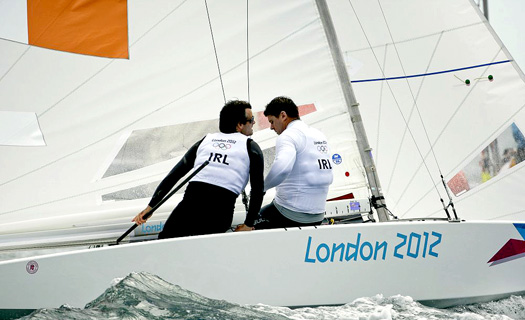
Peter O'Leary and David Burrows (IRL), competing today in the Men's Keelboat (Star) event in The London 2012 Olympic Sailing Competition. Photo: Onedition
A big left hand shift cost O'Leary five places at the second weather mark and put the pair as far back as eighth at one point. The pair fought back strongly though to be sixth by the finish and to put them into second place in the overall regatta standings tonight.
It was a photo finish in Race 2 as Robert Scheidt and Bruno Prada (BRA) overcame Iain Percy and Andrew Simpson (GBR) by the narrowest of margins.
Both teams finished in a time of 73:39 but the race win was awarded to the Brazilians as they took the overall lead having finished fourth in Race 1.
On the race Scheidt said, "We exchanged positions on the second beat, one passing the other all the time and it came down to the finish line. It was a very interesting race. It was so tight that it was hard to see if we won."
Percy and Simpson had a weak start to the competition finishing Race 1 in 11th place but they fought back and almost recorded a bullet in the second place. Simpson said, "It was a tricky race and a good battle at the front. It was very shifty out there and we learnt a few lessons from the first race. We thought we were ahead and it was unbelievably close.
Ireland's David Burrows and Peter O'Leary are second overall after a consistent day that included a second in Race 1 and sixth in Race 2. Meanwhile Mateusz Kusznierewicz and Dominik Zycki (POL) are third overall.
The Star event consists of 10 races and a medal race held between today and Sunday. Race Three gets underway tomorrow at 2.05pm.
Competition at the Games starts for three other Irish sailing campaigns tomorrow with Ryan Seaton and Matt McGovern in the 49er, James Espey in the Laser and Annalise Murphy in the Laser Radial class. Sailing actions starts at 12 noon.
Full results here
Live feeds for racing here
Wind and Rain? Pray for it, Bring it on!
#genuineprospects – If you're contemplating a gentle summer holiday in the south of England in August, forget it. Unless, that is, you see wind and rain of the kind experienced there during the past fortnight as being an essential part of the vacation experience.
With the green and pleasant land becoming grey and soggy and wind-battered last week, Irish teams felt at home and made hay in the Skandia Sail for Gold Regatta at Weymouth. It's the final main event in the countdown to the Olympics at the same venue in August, and went so well for our sailors that by Saturday night the Irish squad were in dazed contemplation of a new store of precious metals.
A Gold Medal for Peter O'Leary and David Burrows in the Star, and Bronze for Annalise Murphy in the Laser Radial. As a bonus, the 49er crew, northerners Ryan Seaton and Matt McGovern, won their fleet and placed seventh overall - their best yet – in the main division.
If this is the kind of scoreline which can be obtained when the going is very bad weatherwise, then let's have more of it. Let's have medals galore even if horrible weather is a key ingredient. Certainly, some of the Irish sailing and Olympic community are praying for such weather in August on a daily basis. And if that fouls up your beachtime in Bognor – tough.
But we should be careful what we wish for. It wasn't wall-to-wall bad weather. The final section last Saturday, the all-important Medal Races, saw the English Channel in classic lively good humour. A sunny breezy day with a good sou'west breeze, 15 knots in the morning, pushing to a brisk and gear-breaking 23 knots after noon, a testing buildup.
The O'Leary-Burrows leap from third into Gold was achieved partly by the duel between the overnight leaders. Britain's Ian Percy and Bart Simpson had been one point ahead of Brazil's Robert Scheidt and Bruno Prada. Then the Brazilians uncharacteristically got themselves into a knot, and had to throw a penalty turn. But Percy and Simpson stayed with them for covering purposes so closely that the Irish team were able to build on a correct tactical decision in the first beat, emerging as deservedly clear and triumphant winners.
Annalise Murphy showed her power in a breeze, and she moved onto the podium, while the Seaton-McGovern progression continued on its merry upward trajectory through the 49er class.
A less happy 49er sailor is Iker Martinez, whose perfect 2012 programme would have been to clinch his early lead in the Volvo Ocean Race at its Galways finish at the end of June, and then go on to race for Spain in the Olympics in the 49er in August.
It was all going along as planned, with Martinez in Telefonica flying the flag with steady success in the first half of the Volvo stages. But in the final stages his campaign has gone wobbled. Most embarrassingly for an Olympian, the inshore racing has been his Achilles heel. Last weekend in Lisbon was excruciating with his rattled crew dropping a sail over the side, and the boat placing last to drop more points, points hard won over thousands of miles of ocean.

Race leaders Groupama Sailing Team, skippered by Franck Cammas from France, with Kerry's Damian Foxall onboard lead the fleet at full speed, on the approach to the finish of leg 8, from Lisbon, Portugal, to Lorient, France, during the Volvo Ocean Race Photo: Paul Todd
Franck Cammas and Damian Foxall with Groupama have gone from strength to strength and top the leaderboard with 189 points to Telefonica's 181. But now with the fleet racing back from rounding the Azores and on towards Lorient, Telefonica is once more in charge, but placings are mighty close in very rugged conditions.
The 2012 ITC Lambay Race at Howth, with a fleet of more than a hundred, saw overall victory for Dun Laoghaire, the Lambay Lady Trophy going to the First 31.7 Blue Fin 2 (Bernie Bryson and Mia Delaney, National YC) after a race so fast the sunshine only caught up with the fleet at the finish.
W M Nixon's sailing column is in the Irish Independent on Saturdays
#genuine prospects – Ireland has won Gold in the Star class and Bronze in the Radial class at the most important pre-Olympic event of the season.
While the boycott reduced Olympics of 1980 may have given hope to the Irish Olympic Sailing team, it is perhaps fair to say that the performances of the class of 2012 are closer to the positive end of the hope-expectation scale. With superb timing, in the last major confrontation of Olympic contenders, the Irish medal race sailors put in tremendous final race performances to take away a first, a third and a seventh from the Skandia Sail for Gold Regatta last week.
With only a few weeks to go to the ultimate competition in this quadrennial, Ireland is set to emulate and perhaps exceed the 1980 result. If we do, it could lessen the burden carried for so long by Wilkins and Wilkinson in the same way that Michael Carruth's gold in Barcelona eventually relieved the nation's unreasonable reliance on Ronnie Delaney.
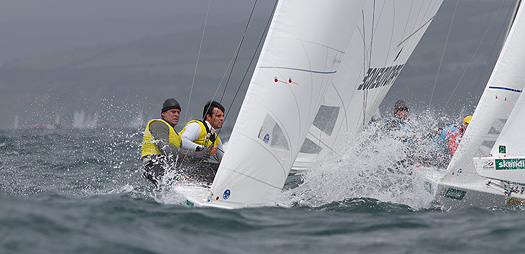
Peter O'Leary and David Burrows on the way to overall victory in the Star class. Photo: Brian Carlin
In the Star Class, Peter O'Leary and David Burrows have been mixing it with the world's best for a couple of years now and in getting the better of current World champions, Brazilians Robert Scheidt and Bruno Prada and the British Olympic Champions, Iain Percy and Andrew Simpson, the Cork/Dublin combo have laid down a very clear message that the destiny of this year's top reward is no longer the two horse race that many punters have been predicting. With consistency across a variety of conditions, the Irish Star team are no longer outsiders for a medal, but have clearly signalled their intention to, once again, ascend the Weymouth podium come August 5th. However, this Star Class is deep with talent and anyone of ten teams could realistically medal. Canada, Switzerland, Poland, France, Denmark and Greece all harbour aspirations to medal in the Star and our heroes will need to double check equipment on a daily basis to ensure they are not denied by equipment failure, particularly with the additional restrictions on coach support during the Games itself.
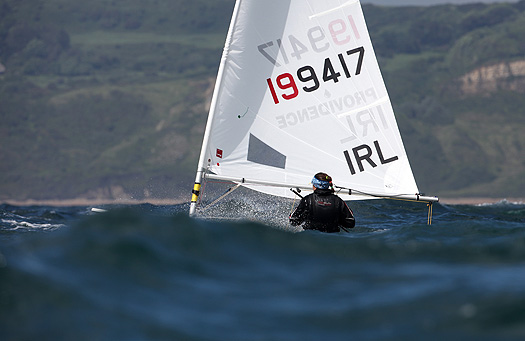
Annalise is recognised as the world leader in heavy airs. Photo: Richard Langdon
Annalise Murphy's welcome return to form, following a Radial worlds dogged by inconsistency and a poor showing (by her standards) at a reduced quality Delta Lloyd regatta, augurs well should Weymouth enjoy decent breeze. Recognised internationally as the class's best heavy weather sailor by some distance, it was encouraging to see that she wasn't completely off the pace in the lighter winds on the regatta's first day. Annalise has set out her schedule for the remaining period prior to the Games – more work on light air sailing work should be a part of the work plan.
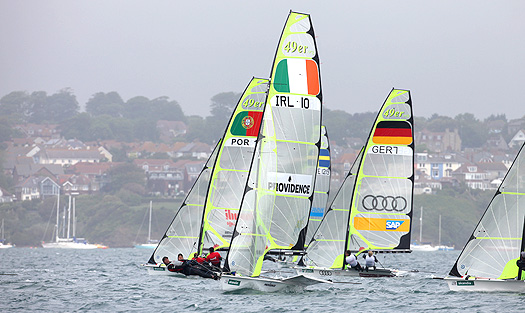
Ryan Searton and Matt McGovern produced three race wins at Sail for Gold last week. Photo: Richard Langdon
Team officials must be delighted, not only with the Star and Radial performances, but also by the 49er team of Ryan Seaton and Matt McGovern. 10th in the 2011 World Championship in Perth must have seemed to be a distant memory with a poor start to 2012.
Less than stellar results in the early season World Cup events culminated in failing to make gold fleet at the 2012 Worlds in Croatia in May last month. However, the Northern Ireland duo bounced back in fine style to record their best result to date. Barely hanging on to the medal race spot in the final gold fleet race, the boys then finished 5th in the medal race, leap frogging three competitors to finish in 7th overall. With three British sailors ahead of them, this conceivably puts them top five in the Olympic fleet. However, form suggests the gold medal battle will be between Spaniards, Iker Martinez and Xabier Fernandez, currently away on Volvo duty, and Australian World Champions Nathan Outteridge and Iain Jensen, with the battle for the minor medal between any number of countries - France, Britain, Finland and Denmark are among those – making the Irish team outsiders. But outsiders with a great boost to their confidence, and this young team, should they continue, will have made a huge claim for enhanced support for the next quadrennial.
So, Irish sailing embarks on the voyage to London 2012 with a reasonable expectation for a positive outcome. But for it to be similar to the Sail for Gold result will not only demand that all our sailors are on their best form, but also that there is consistently strong breeze for the duration. A tall order perhaps? Gaoth láidir, le do thoil!






























